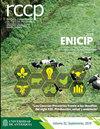喷雾冷却绵羊胴体中大肠杆菌分离株在冷却过程中的耐药性
IF 0.5
4区 农林科学
Q4 AGRICULTURE, DAIRY & ANIMAL SCIENCE
引用次数: 0
摘要
背景:动物源性食品中存在的耐多药细菌引起了人类和动物健康问题。目的:评价经4、10小时水雾冷却的绵羊尸体中分离出的大肠杆菌的耐药性。方法:选取2个屠宰期末次喷水前后的胴体表面拭子各30份。在第一次评估(第1次抽样)中,对3头喷淋冷藏胴体(4小时)、3头未喷淋胴体和1头对照胴体进行抽样。在第二次评估(第2次抽样)中,保持相同的屠体数量和处理方法,但喷雾冷却时间延长至10小时。收集的所有样本分别用16种(第1次取样)和17种(第2次取样)进行药敏试验。结果:总体而言,大肠杆菌分离株对大多数抗菌素具有耐药性。喷雾冷藏和对照(10小时)的尸体对美罗培南有抗药性。结论:从经水喷雾冷却10小时的尸体中分离出的大肠杆菌对1、2和4种抗菌素具有较高的耐药性,具有多药耐药特征。这些结果强调了在整个肉类生产过程中监测健康状况的必要性。本文章由计算机程序翻译,如有差异,请以英文原文为准。
Antimicrobial resistance of Escherichia coli isolates from spray-chilled sheep carcasses during cooling
Background: Multidrug-resistant bacteria present in food of animal origin raise human and animal health concerns. Objective: To assess antimicrobial resistance of Escherichia coli isolates from sheep carcasses subjected to spray-chilling with water (4 and 10 hours) during cooling. Methods: Thirty surface swabs were collected from carcasses before and after the last water spray in two slaughter periods. In a first assessment (1 st sampling), three spray-chilled carcasses (4 hours), three non-sprayed and one control carcass were sampled. In a second assessment (2 nd sampling), the same number of carcasses and treatments were maintained, but spray-chilling was extended to 10 hours. All samples collected were isolated and submitted to susceptibility test using 16 (1 st sampling) and 17 (2 nd sampling) antimicrobials, respectively. Results: Overall, E. coli isolates were resistant most antimicrobials. Spray-chilled and control carcasses (10 hours) showed resistance to meropenem. Conclusion: E. coli isolates from carcasses subjected to spray-chilling with water for 10 hours had higher antimicrobial resistance to one, two, and four antimicrobial classes, characterizing a multidrug resistance profile. These results highlight the need to monitor health status throughout the meat production processes.
求助全文
通过发布文献求助,成功后即可免费获取论文全文。
去求助
来源期刊

Revista Colombiana De Ciencias Pecuarias
AGRICULTURE, DAIRY & ANIMAL SCIENCE-
CiteScore
0.80
自引率
0.00%
发文量
18
审稿时长
6-12 weeks
期刊介绍:
The editors of Revista Colombiana de Ciencias Pecuarias (RCCP) welcome the submission of original manuscripts on experimental and clinical studies associated with the broad areas of animal sciences and veterinary medicine as they interface with biochemistry, molecular biology, physiology, pharmacology, toxicology, pathology, microbiology, parasitology, immunology and epidemiology. The scope of the journal includes studies of basic and applied research in animal management and production, feeding and nutrition, reproduction, breeding, genetics, animal welfare and behavior; as well as animal production focussed from biotechnology, soil science, agrostology, silvopastoral systems, livestock economics and the environment.
The criteria for acceptance of papers submitted for publication are originality, quality and clarity of the content. Each contribution must be based on original, unpublished research that has not been simultaneously submitted to other journals. All papers will be peer reviewed. All authors bear responsibility for ensuring the integrity and quality of their reported research. It is the author''s responsibility to secure permission to use figures or tables that have been published elsewhere.
Contributions may be classified as original research, review, rapid communication, clinical case studies or methodological articles, as well as news/commentaries or letters to the editor. Most review articles are invited by the editor. Authors interested in submitting a review article should contact the corresponding editor. Rapid publication of original manuscripts is a goal of the journal. Manuscripts must be written in English. Each manuscript is considered for publication with the understanding that it has not been simultaneously submitted to any other journal. Upon acceptance for publication, papers are subject to editorial review and revision.
 求助内容:
求助内容: 应助结果提醒方式:
应助结果提醒方式:


